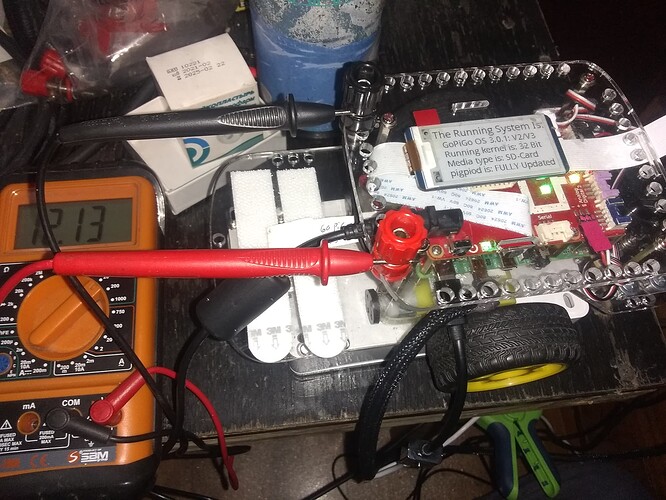Interesting indeed.
I don’t have a fixed voltage source, so I made some measurements based on an initial voltage reading on Carl.
(Carl also running voicecommander, juicer, wheel logger, health check, life logger)
I added an optional command line argument for the sleep_interval,
and removed the rounding of the measured voltage differential after testing showed {:.3f} printed identical means to the rounded means.
(I was worried about compounding rounding error into the means and std deviations.)
Additionally, I wanted to see how the min/max/mean/sdev varied so here are:
- two 10 second runs at 1.0 s
- two 10 second runs at 0.1 s
- two 60 second runs at 1.0 s
- two 60 second runs at 0.1 s
- two 120 second runs at 1.0 s
- two 120 second runs at 0.1 s
We took 10 measurements at 1.0 seconds (based on reference voltage of 10.057)
min: -0.128 max: 0.000 mean: -0.071 sdev: 0.043
We took 103 measurements at 0.1 seconds (based on reference voltage of 9.997)
min: -0.205 max: 0.000 mean: -0.160 sdev: 0.037
We took 105 measurements at 0.1 seconds (based on reference voltage of 10.091)
min: -0.103 max: 0.060 mean: -0.056 sdev: 0.026
We took 10 measurements at 1.0 seconds (based on reference voltage of 10.048)
min: -0.120 max: 0.000 mean: -0.075 sdev: 0.033
We took 60 measurements at 1.0 seconds (based on reference voltage of 10.022)
min: -0.129 max: 0.085 mean: -0.084 sdev: 0.038
We took 60 measurements at 1.0 seconds (based on reference voltage of 9.98)
min: -0.145 max: 0.043 mean: -0.108 sdev: 0.038
We took 605 measurements at 0.1 seconds (based on reference voltage of 9.98)
min: -0.120 max: 0.120 mean: -0.072 sdev: 0.033
We took 638 measurements at 0.1 seconds (based on reference voltage of 9.851)
min: -0.214 max: 0.017 mean: -0.158 sdev: 0.036
We took 1200 measurements at 0.1 seconds (based on reference voltage of 9.466)
min: -0.154 max: 0.146 mean: -0.091 sdev: 0.044
We took 121 measurements at 1.0 seconds (based on reference voltage of 9.466)
min: -0.128 max: 0.035 mean: -0.083 sdev: 0.037
We took 120 measurements at 1.0 seconds (based on reference voltage of 9.483)
min: -0.103 max: 0.086 mean: -0.056 sdev: 0.043
We took 1202 measurements at 0.1 seconds (based on reference voltage of 9.431)
min: -0.146 max: 0.154 mean: -0.096 sdev: 0.042
pi@Carl:~/Carl/Examples/voltagereadspeed $
I don’t think I can see a significant difference between 1.0s readings and 0.1s readings,
but I it might take a lot more tests to be confident of that.
Having a nice fixed voltage source would allows longer runs,
but perhaps the standard deviation is related to the varying processor load more than A2D variation.
I have no idea how to characterize the constantly changing processor load.
If I was going to try to hypothesize why 0.1 s readings might have greater accuracy over 1.0 second readings,
I would propose that the processor load changes less in 0.1 seconds than in 1.0 seconds,
but that is just wild free running brain storming.
How I changed the program:
#!/usr/bin/python3
# FILE: batt_test.py
# PURPOSE: Characterize GoPiGo3 battery voltage measurements
"""
USAGE: ./batt_test.py [-h] [-i INTERVAL]
optional arguments:
-h, --help show this help message and exit
-i INTERVAL, --interval INTERVAL (n.n in seconds, default=1.0)
"""
import sys
from easygopigo3 import EasyGoPiGo3
from time import sleep
import argparse
import statistics
argparser = argparse.ArgumentParser(description='batt_test.py Characterize GoPiGo3 battery voltage measurements')
argparser.add_argument('-i', '--interval', dest='interval', type=float, help="n.n in seconds, default=1.0",default=1.0)
args = argparser.parse_args()
sleep_interval_seconds = args.interval
mybot = EasyGoPiGo3()
# value = 0
values = []
count = 0
# Reference_Input_Voltage = 12.0
Reference_Input_Voltage = mybot.get_voltage_battery()
file1 = open("./voltage_test.txt", "a")
def round_up(x, decimal_precision=2):
# "x" is the value to be rounded using 4/5 rounding rules
# always rounding away from zero
#
# "decimal_precision is the number of decimal digits desired
# after the decimal divider mark.
#
# It returns the **LESSER** of:
# (a) The number of digits requested
# (b) The number of digits in the number if less
# than the number of decimal digits requested
# Example: (Assume decimal_precision = 3)
# round_up(1.123456, 3) will return 1.123. (4 < 5)
# round_up(9.876543, 3) will return 9.877. (5 >= 5)
# round_up(9.87, 3) will return 9.87
# because there are only two decimal digits and we asked for 3
#
if decimal_precision < 0:
decimal_precision = 0
exp = 10 ** decimal_precision
x = exp * x
if x > 0:
val = (int(x + 0.5) / exp)
elif x < 0:
val = (int(x - 0.5) / exp)
else:
val = 0
if decimal_precision <= 0:
return (int(val))
else:
return (val)
try:
print("batt_test with read interval {:.2f} seconds".format(sleep_interval_seconds))
while True:
# Measured_Battery_Voltage = round_up(mybot.get_voltage_battery(), 3)
Measured_Battery_Voltage = mybot.get_voltage_battery()
Five_v_System_Voltage = round_up(mybot.get_voltage_5v(), 3)
# Measured_voltage_differential = round_up((Reference_Input_Voltage - Measured_Battery_Voltage),3)
Measured_voltage_differential = Reference_Input_Voltage - Measured_Battery_Voltage
# value = value + Measured_voltage_differential
values.append(Measured_voltage_differential)
count = count+1
print("Measured Battery Voltage =", Measured_Battery_Voltage)
print("Measured voltage differential = ", Measured_voltage_differential)
print("5v system voltage =", Five_v_System_Voltage, "\n")
print("Total number of measurements so far is ", count)
sleep(sleep_interval_seconds)
except KeyboardInterrupt:
print("\nThat's All Folks!\n")
data="\nWe took " + str(count) + " measurements at {:.1f}".format(sleep_interval_seconds) + " seconds (based on reference voltage of " + str(Reference_Input_Voltage) + ")"
print(data)
file1.write(data)
file1.write("\n")
data="min: {:.3f} max: {:.3f} mean: {:.3f} sdev: {:.3f} \n".format(min(values), max(values), statistics.mean(values), statistics.pstdev(values))
print(data)
file1.write(data)
file1.close()
sys.exit(0)
 At least it wasn’t a
At least it wasn’t a  .
.


 )
)